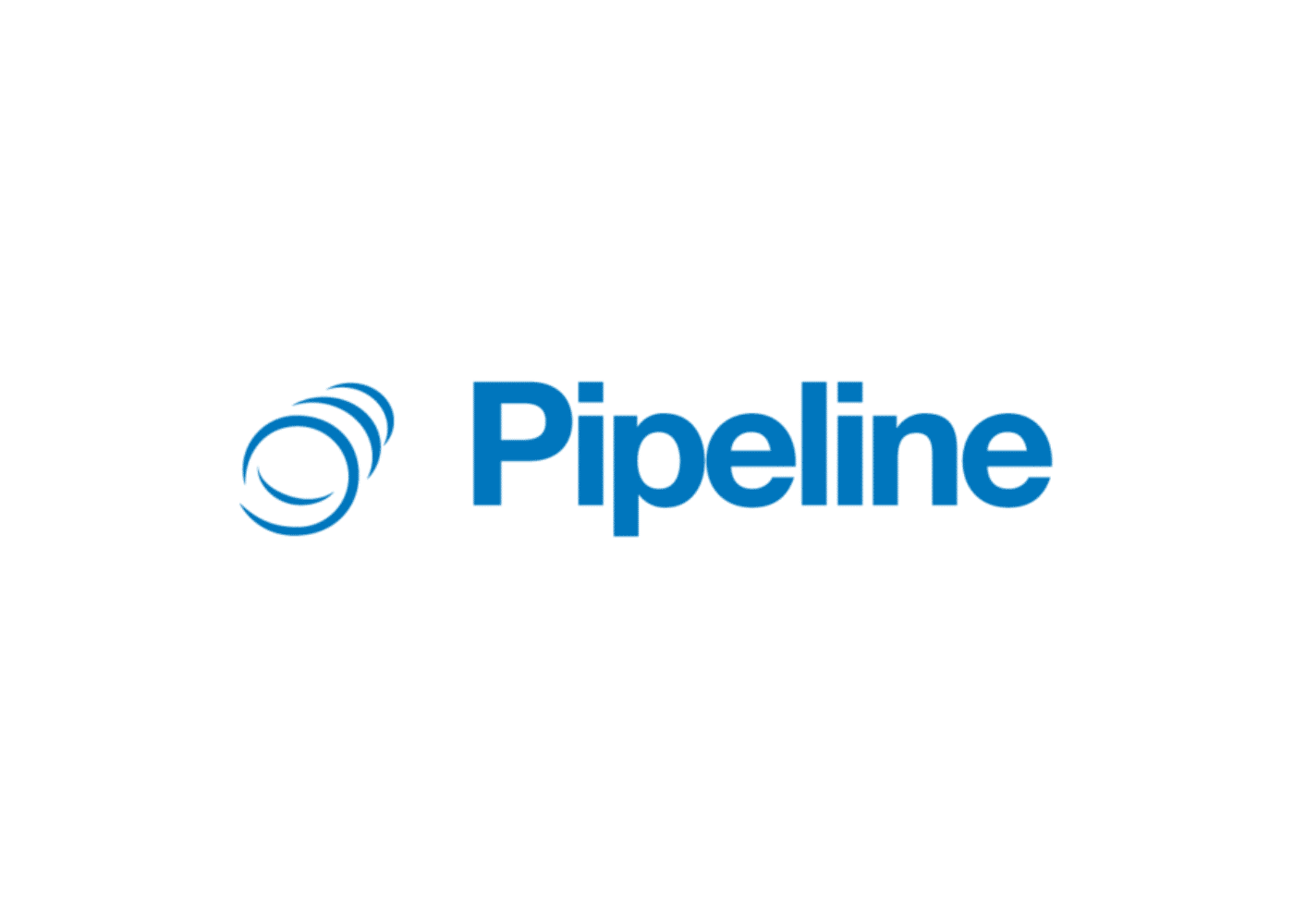Pipeline CRM
Learn More Today!-
Powerful Pipeline Management
-
Customizable Dashboards
-
Email Sync & Automation
Let’s face it, finding the right CRM can be tricky. Especially without the right information to help find something that fits your specific needs.
Choosing the wrong CRM can result in mismanaged data, lost leads, and time spent trying to recoup your losses.
I’m AJ, and I’m here to make sure that doesn’t happen. I’ve had a ton of experience using CRMs as I built up and sold my digital agency to a successful multi-million dollar exit.
Now I’m here to impart that knowledge to my fellow entrepreneurs and small business owners.
For this review, we looked at Pipeline CRM specifically. The Small Business Bonfire team and I took a deep dive into everything from features and pricing to customer support and practical use cases.
You Can Trust Small Business Bonfire
Since 2009 Small Business Bonfire has been testing and rating thousands of business software to help you (our small business owners) start & scale your organizations. If you want to know more about how we test, please read this article here.
What is Pipeline CRM?
Pipeline CRM is a user-friendly CRM software that, at its core, helps businesses manage customer information, automate actions, and streamline sales processes.
As the name might suggest, Pipeline is focused on, well, pipeline management.
Pipeline CRM is designed to help businesses focus their efforts on the customers who offer the most potential for success.
Throughout our testing, we found it to be an affordable and scalable service that specializes in managing contacts, leads, and deals.
As a result, we recommend it specifically for small and midsize businesses (SMBs) looking to grow their marketing efforts, empower their sales teams, and streamline their pipelines.
Here are some features that Pipeline CRM provides:
- Dashboard & calendar views
- Contact management
- Pipeline management
- Agenda tracking
- A great mobile app
- Powerful reporting & analytics
- Email automation & sync
We tested Pipeline CRM by signing up for their Grow plan and then really got into it!
Pros and Cons of Pipeline CRM
We’ve already touched on some great features that the CRM software offers; however, it’s also important to discuss the drawbacks. Here are some pros and cons of Pipeline CRM.
Pipeline CRM Pros
- Affordable pricing
- Fantastic pipeline management tools
- Great contact management capabilities
- Helpful activity tracking features
- Intuitve user interface
- Beginner-friendly
Pipeline CRM Cons
- No free plan
- Limited marketing features
Who Is Pipeline CRM Best Suited For?
As we touched on previously, Pipeline CRM is best suited for sales-focused small and midsize companies that are planning on scaling up.
Let’s break it down:
- Small businesses – Pipeline CRM is very affordable, with the most expensive (Grow) plan costing only $49/month (billed annually). This makes it perfect for small businesses that want to take advantage of powerful features without breaking the bank.
- Midsize businesses – Pipeline offers a ton of helpful marketing automation and pipeline management capabilities to streamline your midsize business. It’s fantastic at making a mountain of work feel like a walk in the park. This allows you to focus on what matters—your customers.
Who is Pipeline CRM Not Suited For?
Let’s face it, no platform is perfect. Let’s look at some situations where we think Pipeline CRM isn’t the best fit.
These include the following:
- Large enterprises – Pipeline’s CRM platform is not really the best fit for larger organizations and enterprises. While they offer a lot of great features to track, manage, and streamline sales, they are limited in terms of the integrations and automation capabilities often needed by larger companies.
- Marketing agencies – While Pipeline CRM offers some basic marketing features (and some great marketing automation), it lacks some advanced features such as landing page creation, A/B testing, and ad campaign creation.
Pipeline CRM Pricing: How Much Does It Cost?
Pipeline has 3 plans to choose from. They also offer a 14-day free trial for each plan.
Pipeline’s 3 plans (billed annually) are the following:
- Start Plan – $29/Month
- Develop – $39/Month
- Grow – $59/Month
Checkout our full overview of Pipeline’s pricing here!
How Does Pipeline CRM Pricing Compare?
Let’s see how Pipeline stacks up against the competition in terms of pricing and features.
We’ll compare the platform to four of the most popular CRMs in the game.
Pipeline – $29/Month
- No free plan
- Advanced pipeline management
- Great contact management
- Easy-to-use platform
- All features included
EngageBay – $14.99/Month
- Free plan
- Advanced pipeline management
- Great contact management
- Very easy to use
- All features included
HubSpot – $30/Month
- Free plan
- Advanced pipeline management
- Great contact management
- Has a bit of a learning curve
- All features included
Pipedrive – $21.90/Month
- No free plan
- Advanced pipeline management
- Great contact management
- Easy-to-use platform
- Requires add ons
In terms of pricing, EngageBay is the clear winner here at just $14.99/Month. However, Pipeline offers affordable pricing, great pipeline management, and is easy to use—what’s not to love?
Pipeline Pricing Tips
Pipeline CRM Software Features
The Pipeline Management feature is the heart and soul of Pipeline CRM, and we put it through its paces over a three-month period.
This feature is designed to streamline the sales process, allowing you to accomplish the following:
- Create new deals
- Track progress
- Close more sales
We tested this by adding some of our affiliate marketing partnerships into our sales pipeline.
Let's break it down.
To create a new deal, it's as simple as clicking the 'add deal' button.
Here's how it looked from our perspective.
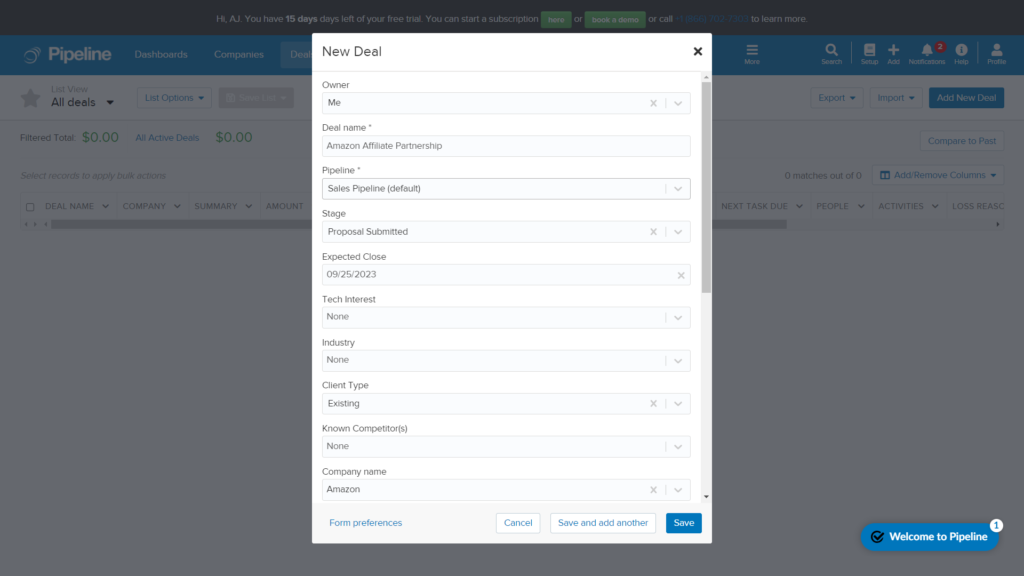
With each deal card, we were able to add the following information:
- Owner
- Name
- Associated pipeline
- Stage
- Close date
- Client type
Once a deal was set up, we were able to manage and track its progress from our pipeline (shown below).
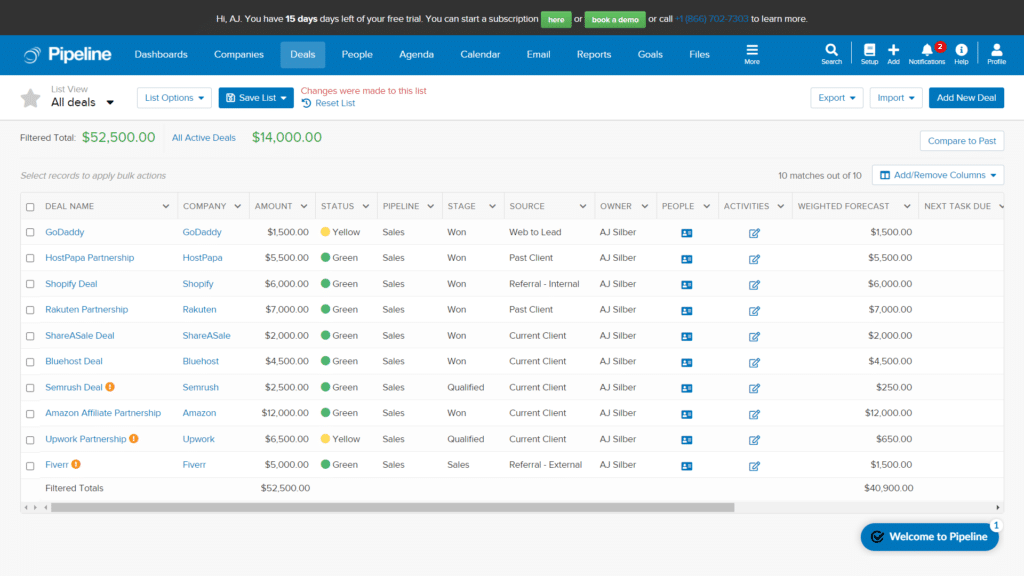
As you can see, the visual representation of our sales pipeline in the dashboard is clean and intuitive.
Each stage of the sales process is clearly laid out, and we could easily drag and drop deals from one stage to another.
Having all this information visually represented and easily accessible in one place boosted our productivity and made managing partnerships a breeze.
Keeping track of the who, what, when, and where of your daily tasks is a breeze with Pipeline CRM's agenda management tools.
By simplifying and streamlining your to-do list, this feature ensures you never miss a beat.
Throughout our three months of testing, our team found this tool particularly handy for setting priorities and staying on top of tasks.
We added in some typical tasks at SBB (such as following up with affiliate marketing clients).
Here's how the "new task" screen looked (to give you a better idea).
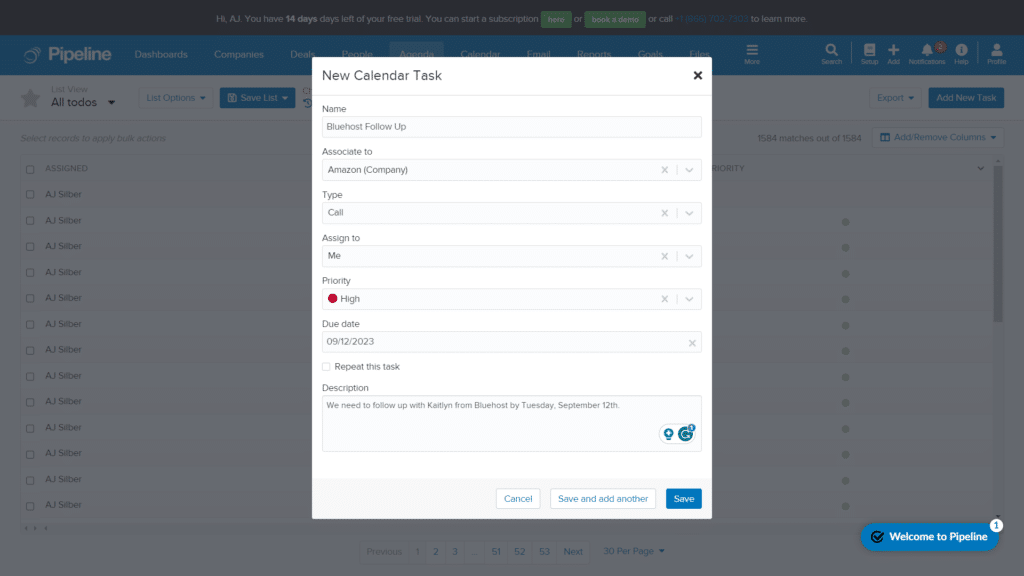
Adding a new item to the agenda was simple and intuitive.
We were able to quickly input the essentials such as:
- Task description
- Assigned team member
- Due date
- Priority level
Pipeline CRM also gives you the option to tailor fields according to your specific organizational needs, putting you in charge of how you track and manage your tasks.
Our takeaway: Effective agenda management might not be the most glamorous part of a CRM, but it's undeniably crucial. And when it comes to this, Pipeline CRM definitely delivers!
Let's talk about another feature we love—the dashboard view.
It's like the control room for all your data, and we all know how important data-driven decisions are, especially here at Small Business Bonfire.
Here are some cool things about the Dashboard View:
Snapshot of key metrics: The dashboard provides a snapshot of all your key metrics at a glance. You can monitor your sales performance, track lead generation, and view deal progression—all in real time.
Customizable: You can customize your dashboard to display the information that's most important to your business. Want to see your sales targets upfront? No problem. Need to track customer interactions? Just add it to your dashboard.
Visual representation: The dashboard provides visual representations of your data, such as graphs and charts, making it easier to understand, analyze, and present.
Access to reports: Want detailed reports on your sales performance? The dashboard has got you covered. You can access various detailed reports right from the dashboard.
Here's a screenshot of our dashboard during our testing period.
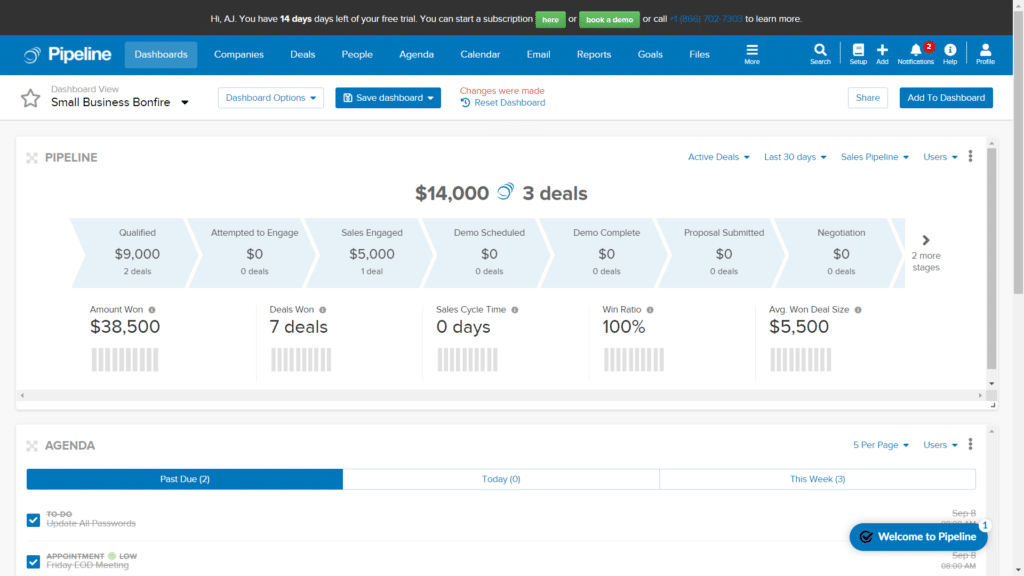
We swear by making data-driven decisions at Small Business Bonfire, and the Dashboard View made that incredibly easy for us.
Whether we were tracking our progress towards sales targets or analyzing lead generation data, everything we needed was right there.
Pipeline's CRM service provides account management customizations that allow users to tweak their accounts as their needs change.
Some settings that you can customize include the following:
- Adding new users
- Create custom fields
- Add deal stages
- Set up categories
- Build forms
We were impressed with the level of flexibility Pipeline CRM provided, allowing us to tailor our account to meet the specific needs and goals of Small Business Bonfire.
Here's the "add new user" form. It was quick and easy to alter permissions, team role, and send the invite to our new team member.
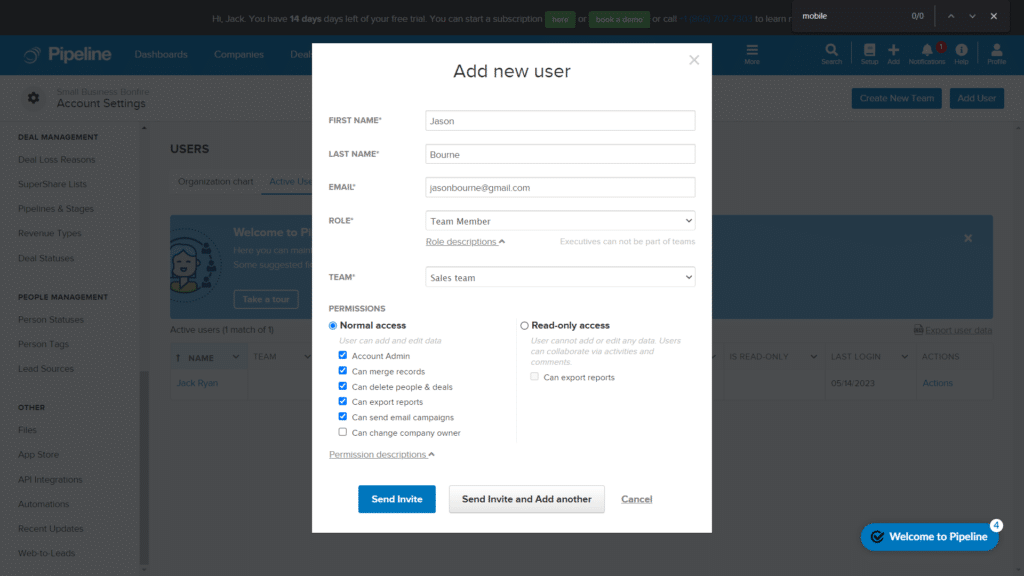
Another handy-dandy feature of Pipeline CRM is the Calendar View & Sync. This feature allows you to have a bird's eye view of everything that's scheduled, due, overdue or anywhere in between.
Let's look at what this feature brings to the table:
- Overview of activities: With the Calendar View, you have a clear view of all your activities - calls, meetings, tasks, deadlines, you name it. You can see what's on the docket for the day, what's coming up for the week, or even the entire month.
- Sync with other calendars: One of the best parts about this feature is the ability to sync it with your existing calendars. Whether you're using Google Calendar, Apple Calendar, Outlook, or any other, Pipeline CRM's got you covered.
- Color-coded entries: Entries in the calendar are color-coded, so you can quickly identify different types of activities or tasks. It's not just practical; it also makes the calendar view more vibrant and easier on the eyes.
- Drag & drop rescheduling: Have a meeting that got postponed or a task that needs to be rescheduled? No problem. With the drag-and-drop functionality, moving things around on your calendar is a breeze.
And now, drumroll please—here's our monthly calendar view during our testing of Pipeline.
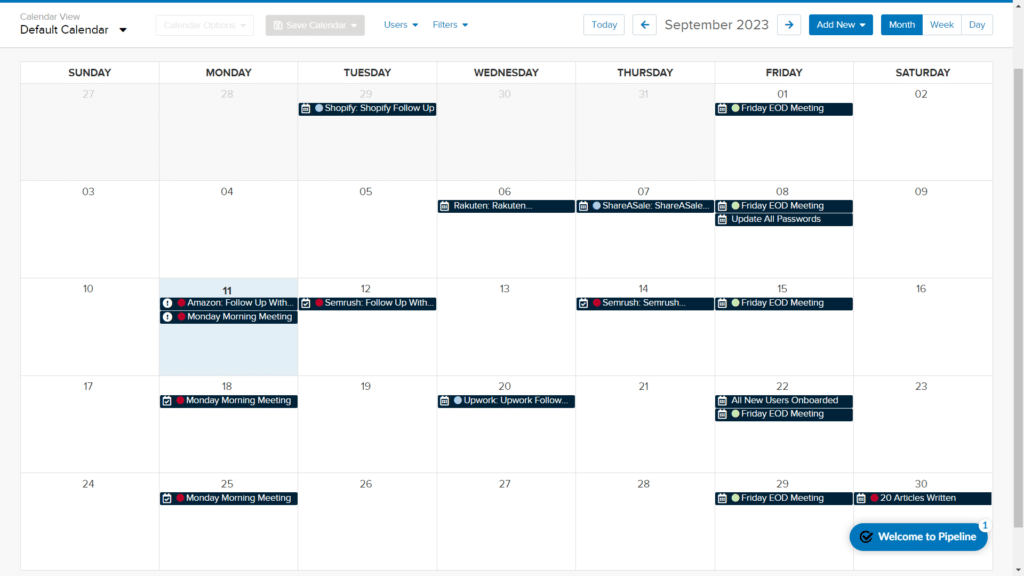
At the end of the day, the calendar feature is a fantastic tool that not only keeps your schedule organized but also ensures you never miss a beat when it comes to managing your tasks and activities.
Pipeline CRM has automated contact management tools that allow users to easily manage contacts across multiple channels at once. These are separated into "companies" and "people."
Using Pipeline's contact management system, users can do the following:
- Track total pipeline campaigns
- Edit activities in real time
- Create custom fields
- Merge duplicate contacts
- Import/export contacts
- Organize contacts into lists
We found this feature especially useful for tracking leads, customers, and prospects.
In order to really test it out, we added our B2B affiliate marketing contacts at Small Business Bonfire.
Here's how it looked to add a new contact.
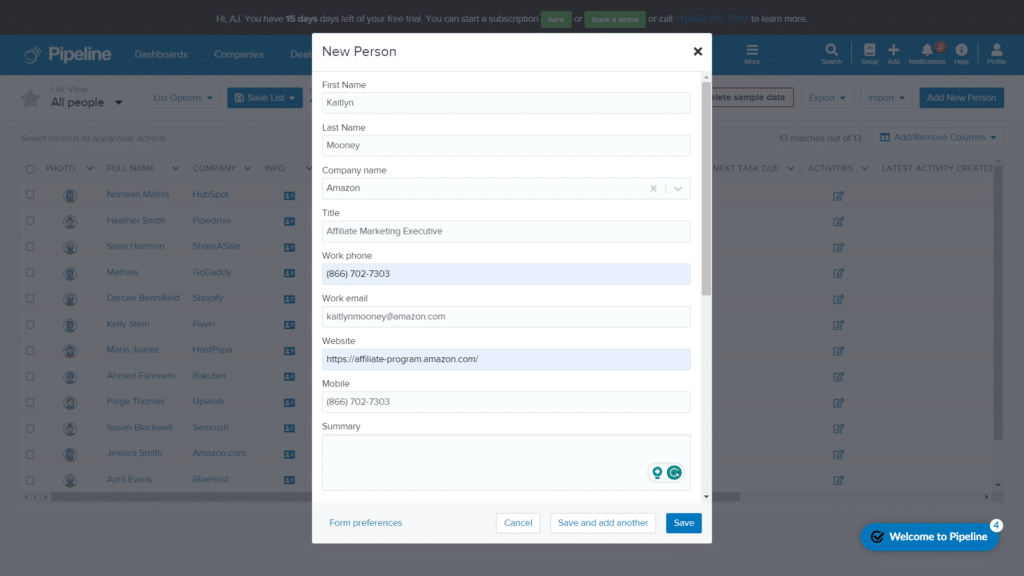
Within each contact card, we were able to add the following information:
- Name
- Company
- Title
- Contact information
- Website
- Summary
Here's a sneak peek of our dashboard during our three months of testing.
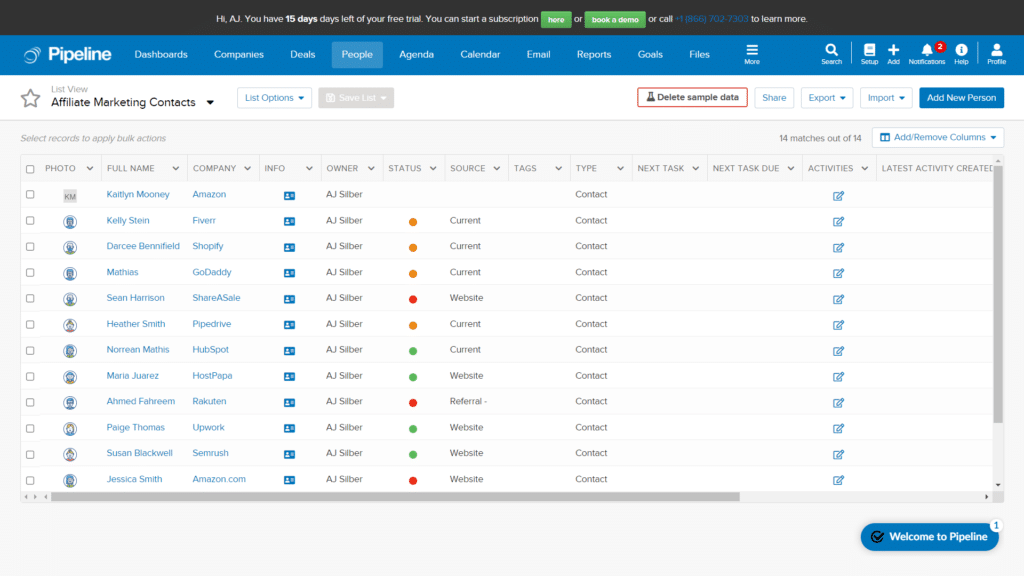
As you can see, everything is laid out in a way that's extremely intuitive and easy to read.
The bottom line: When it comes to contact management, Pipeline is one of the best in the biz. If you're looking to get organized (without breaking the bank), our money is on Pipeline!
Pipeline's CRM platform provides powerful email capabilities, including the following features:
- Inbox sync
- Bulk email
- Email campaigns
- Analytics
- Templates
Users can sink their email from Google or Microsoft Exchange so that all their emails are in one place.
Syncing your email is as easy as the click of a button.
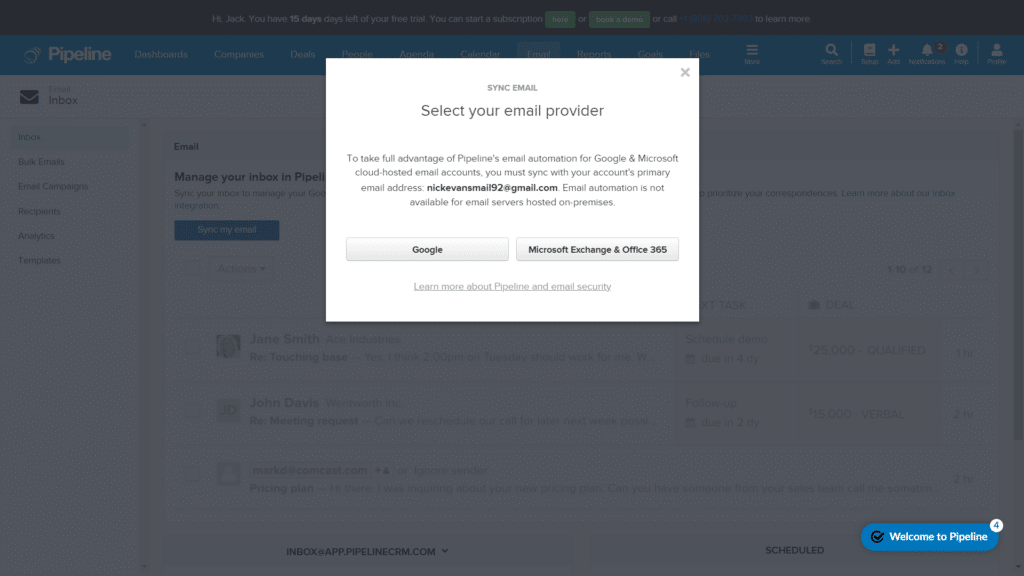
Once you've synced your inbox up, you can create your email campaign. You can assign various steps of the campaign, and even decide when certain emails are sent during the campaign.
It's not the most intuitive automation, but it works.
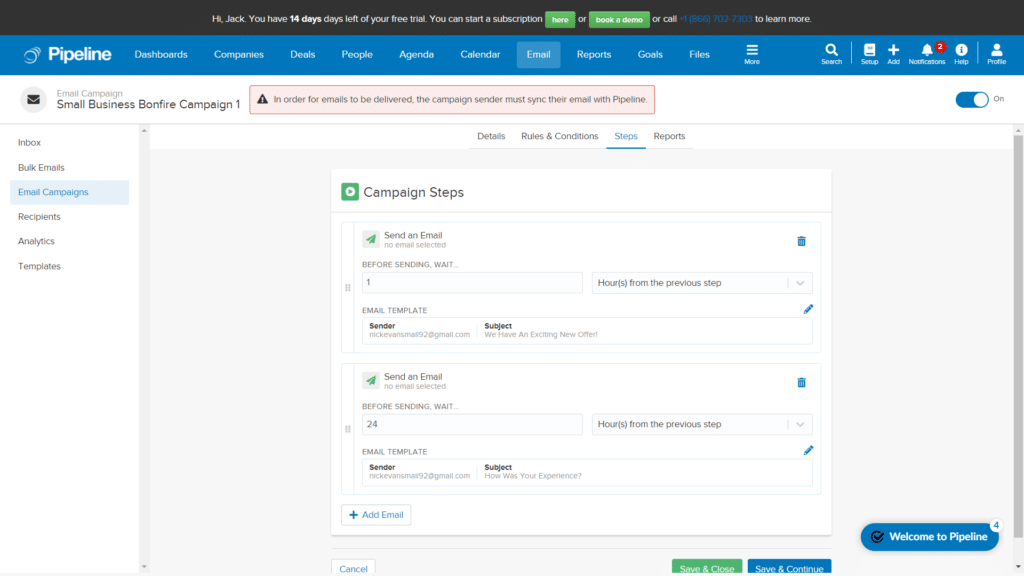
Overall, while there are better email marketing platforms out there, Pipeline certainly holds its own (in our opinion).
Pipeline CRM offers a robust reporting feature that allows users to track their team's performance and productivity effectively.
With the advanced reporting tools, managers can create reports based on various metrics such as deals won, lost, and pipeline value, helping them gauge their team's performance.
Plus, the platform provides real-time insights into the following:
- Individual performance
- Highlighting areas of improvement
- Identifying high-performing sales reps
Throughout our months of reviewing the product, we found the reporting options easy to navigate and the reports to be visually appealing and informative.
What are the Limitations of Pipeline CRM?
Pipeline CRM, like any other software, comes with some limitations.
One of our main concerns is the absence of comprehensive integrations with other third-party software. It does have some, but the list left something to be desired in our opinion.
CRM users need to be able to access data collected from other software integrated into their business processes. This is especially true for large organizations that utilize a lot of other apps.
What Sets Pipeline CRM Apart from the Competition?
Pipeline CRM stands out as a fantastic customer relationship management platform because of its affordable pricing and robust CRM features.
It is available to businesses on almost any budget, making it one of the most accessible CRMs on the market.
Although it doesn’t have the most impressive integrations or workflow automation capabilities, it provides more than your average CRM at an impressive price point.
Getting Started with Pipeline CRM
The setup process was simple with Pipeline’s CRM software.
To get started, we navigated to the homepage (shown below), where we were greeted with a bright green call-to-action (CTA).
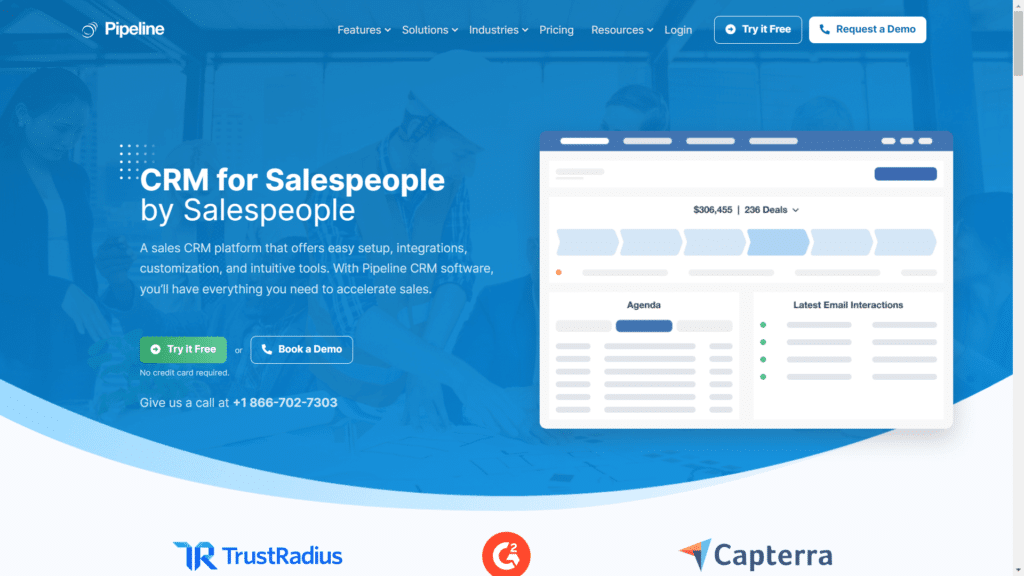
From there, we filled out a few fields, including the following:
- Name
- Business name
- Team size
We then verified our email, and we were off!

Pipeline has helpful demos that we used to navigate our way around the site for the first few minutes until we got acclimated.
All in all, the onboarding process was made easy with a simple user interface and Pipeline’s tutorials!
How Do You Use Pipeline CRM?
Pipeline CRM can be used for every stage of the customer lifecycle.
From creating contact lists and tracking leads to managing sales pipelines and analyzing performance, businesses of all sizes can benefit from Pipeline’s robust features.
We recommend it for businesses that are serious about scaling up their sales and marketing efforts.
Pipeline CRM Customer Service & Support Review
In terms of customer support, Pipeline CRM offers live chat, email, and phone support.
They also offer the following:
- Helpful knowledge base
- Tutorial videos
- Scheduled demos
To test the responsiveness of the service team, we reached out via email with a question about Slack integration.
We received a response within minutes (which was awesome). However, we were able to find the answer to our question before we even heard back by utilizing the knowledge database!
Overall, we’d give Pipeline’s customer service a 10/10.
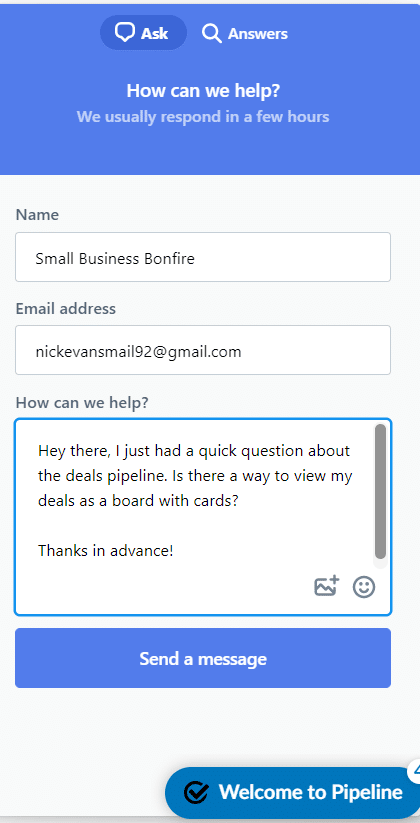
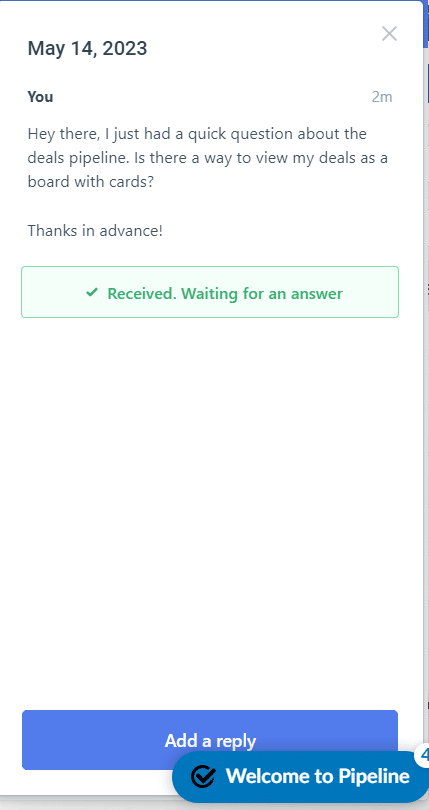
Pipeline CRM Integrations
Having the ability to integrate your CRM with other programs that your business utilizes is key.
Pipeline offers a few fantastic native integrations with popular platforms.
These include the following:
- Mailchimp
- Outlook
- QuickBooks Online
- Zapier
- Excel
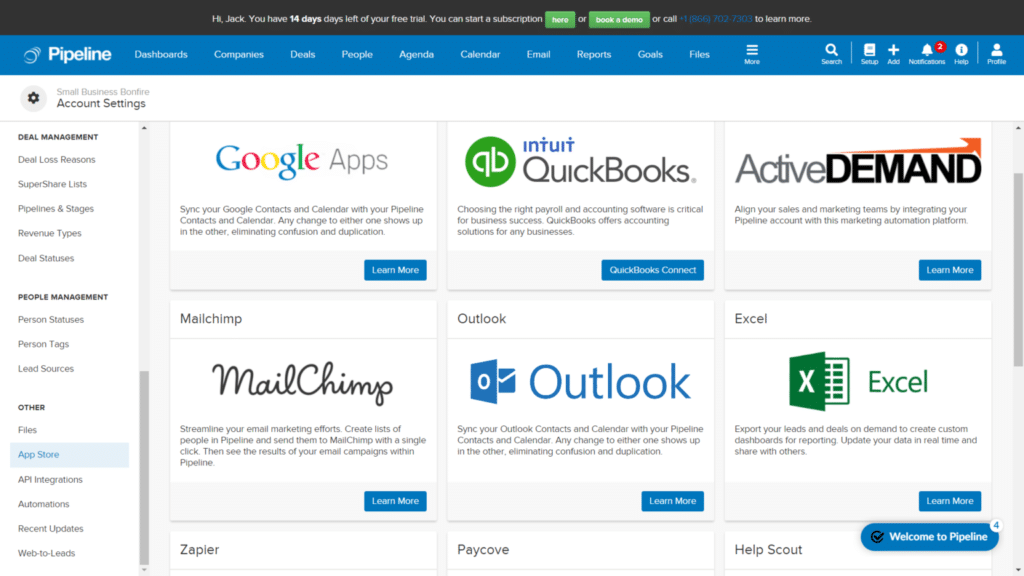
Plus, with the Zapier integration that Pipeline offers, you can integrate thousands more third-party apps!
When you’re running a business, it’s important to have all the best tools at your disposal. With Pipeline’s native and third-party integration capabilities, that’s entirely possible!
Pipeline CRM Alternative Comparison
Although Pipeline is a fantastic CRM platform, there are other options out there. Here is an overview of some other great choices in our opinion.
Is Pipeline CRM Worth it for Small Business Owners?
Pipeline CRM is an excellent choice for small businesses looking to optimize their customer relationship management.
We were impressed with the flexibility and scalability of this software, and would highly recommend it as a great option for SMBs.
Ultimately, we advise that you try the free trial today! If it helps your business at all, take the plunge with their extremely affordable Grow plan.
Frequently Asked Questions About Pipeline CRM
Yes, Pipeline is considered to be a very good CRM by many businesses and users around the world.
It is designed to help companies manage their sales pipeline and track their sales and marketing activities effectively.
Users can customize the CRM to their specific needs and preferences, and it offers various features to help organizations optimize their sales and marketing processes.
One of the key benefits of Pipeline is its ease of use. The software is user-friendly and intuitive, making it accessible even to those who are new to CRM technology.
It is also very flexible in terms of customization and integration with other tools and applications, so businesses can tailor it to fit their specific requirements.
Pipeline CRM is a customer relationship management (CRM) tool that helps businesses manage their sales pipeline and track their sales and marketing activities.
It allows users to keep track of leads, prospects, and customers throughout the sales cycle, from initial contact to closing the deal.
Overall, Pipeline CRM offers a complete solution for businesses looking to manage their sales and marketing operations effectively.
Yes, Pipeline is a CRM system. As mentioned earlier, it is designed to help businesses manage their customer relationships and sales pipeline.
It offers features like lead capture and management, deal tracking, and sales reporting, which are all core functions of a CRM system.
No, Pipeline is not the same as Pipedrive. While both are CRM tools designed to help businesses manage their sales pipeline and track their sales and marketing activities, they are developed by different companies and have their own unique features and functionalities.
Pipedrive is known for its visual sales pipeline, which provides users with a clear and simple overview of their sales processes.
It also offers email sync, workflow automation, and integrations with over 200 apps, among other features.
On the other hand, Pipeline is known for its simplicity and ease of use, as well as its flexibility in terms of customization and integrations.
It offers features like lead capture, reporting, and mobile app access, among others.
Pipeline is popular among businesses for a number of reasons. Firstly, it is known for its simplicity and ease of use, which makes it accessible even to those who are new to CRM technology.
This has helped it gain a loyal user base, especially among small and medium-sized businesses.
Secondly, Pipeline offers a high degree of customization and flexibility. Users can tailor the CRM to their specific needs and preferences, and it can be integrated with other tools and applications that they use.
Thirdly, Pipeline is affordable compared to many other CRM tools on the market. This makes it an attractive choice for businesses with limited budgets.
Overall, Pipeline’s combination of simplicity, flexibility, and affordability has helped it become a popular choice for businesses of all sizes and industries.
Newsletter Signup
Join The Leads Field Guide Newsletter for tips, strategies and (free) resources for growing your leads, and closing more deals.

